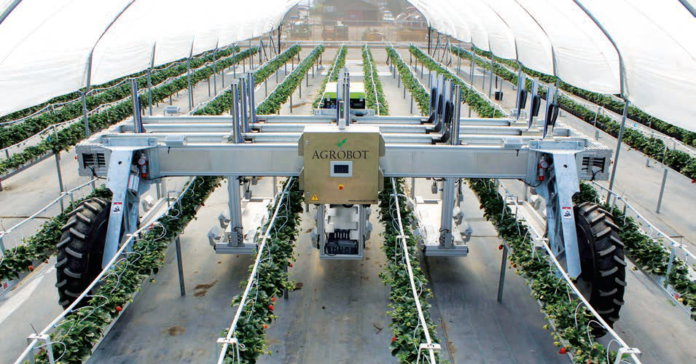Dr. Eamonn Kehoe, the Teagasc soft fruit specialist, gives an update on the most recent developments in the area of robotics developments in the European soft fruit industry
The recent recession impacted on every part of our economy and the landscape sector had no immunity card to play. Despite hopeful discussions and predictions that many Irish people had built up big reserves in savings and that they would spend a lot of this on renovating their houses and more importantly would splurge huge amounts on their gardens (in lieu of going on that second and third holiday and being less vulgar than upgrading to the new car). It never happened. The contraction in the economy was mirrored in the contraction of the size of landscape companies. Ironically, the number of landscape contractors (individuals or companies offering ‘landscape’ services’) increased, tax compliant or otherwise, incrementally in ratio to the continuation of the recession.
LABOUR CRISIS HISTORY
When I started working for Teagasc in Wexford back in the autumn of 2000, I walked straight into a labour crisis. There was a big shortage of labour in the soft fruit industry.
“This machine alone has led to a 60% reduction in the picking staff”
In Wexford alone, there was a severe shortage of strawberry pickers. These were mostly needed to work for those who were growing strawberries for the processing industry (e.g. Chivers). A scheme had been developed to allow Polish students to come to Wexford to work for local strawberry growers.
The scheme worked very well. When this scheme ended, growers started to apply for non-EU workers through a government work permit scheme. Shortly after this, Poland and Romania joined the EU and therefore growers generally didn’t need to apply for work permits anymore. There was a good supply of foreign labour willing to work on fruit farms.
THE LABOUR CRISIS RETURNS
Today the labour crisis has returned with a vengeance. We are back to a similar situation as seen in 2000. There is now a serious shortage of labour and growers once again have to apply for work permits from non-EU accession states. So we have come full circle with regard to labour supply. The process of finding good foreign workers and applying for work permits is tedious and expensive.
As Winston Churchill once said, “Never let a good crisis go to waste”. This saying is so true. Crises like these force people to innovate much more quickly. Never underestimate people’s ability to face up to challenges when they have no choice.
The alternative is having no staff to pick the fruit. While there has always been a drive towards greater productivity and efficiency on fruit farms, there have been no major advances in ways to increase the efficiency of strawberry picking.
SMART TECHNOLOGY FOR STRAWBERRY PICKING?
For years I have been told that strawberries would always have to be picked by hand. A machine to do so would never be developed. Never say the word ‘never’ because currently there are a number of strawberry picking robots in development in Europe and the United States.
A number of robotic harvesters are currently being developed by the Spanish company Agrobot, based in Huelva in the southwest of Spain. Huelva is the largest strawberry production area in Europe, and many Irish growers have visited the area over the years.
One of the machines was originally developed for harvesting field strawberries grown in raised beds. This machine alone has led to a 60% reduction in the picking staff. What previously took 10 people to pick one acre of strawberries now takes no more than four. Two people stay working in the strawberry field and two remain sitting on the machine packing the strawberries that have come up the harvesting belt.
The biggest cost for the strawberry grower is that of labour, a cost which always keeps increasing. With the use of the Agrobot robot, the labour cost is drastically reduced. Another more recent robot from Agrobot is specifically designed for tabletop strawberry production. The labour requirement is cut by up to 80 percent with this robot. The robot has been trialled successfully with a number of commercial growers in Belgium and the Netherlands.
The robot also has a very adaptable configuration. The platform can fit into almost any tabletop layout. The machine uses 24 robotic arms which work together tirelessly as a team. Imagine the benefits of this. Not alone are labour costs drastically reduced but there will be no staff bickering in the fields and nobody dodging work.
HOW ARE THE STRAWBERRIES HARVESTED?
The robot has a sophisticated harvesting system. It uses a number of short-range integrated 3D colour and infrared depth sensors. These sensors are used by an artificial intelligence (AI) system to determine the stage of fruit ripeness. When the system determines a strawberry is ripe, a robotic arm reaches out to the individual fruit. The strawberry can be harvested with the stem attached, with the stem removed, or with both the calyx and stem removed. The robotic harvester does not touch the fruit. The robotic arms grip and cut the strawberry stem and then place the strawberry into a strawberry punnet.
MORE ADVANTAGES FROM ROBOTIC HARVESTING
There is another huge benefit apart from the huge savings in labour costs. The robot can work any time of the day or night. It can keep working and doesn’t need to take tea or lunch breaks or any other type of breaks. It won’t need to take holidays and won’t cause staff disputes.
The advantages of robotically harvesting fruit at night are equally immense. Strawberries are harvested at much cooler temperatures compared to those during the daytime. This greatly reduces the risk of damaging the strawberries and will greatly increase the shelf life.
OTHER ROBOTS?
Another company which is currently developing a strawberry picking robot is the Belgian company Octinion. This robot is also designed for harvesting strawberries grown on tabletops. The robot is a prototype and is also fully autonomous. It also uses a 3D vision system to detect the stage of strawberry ripeness. In this case, however, the robot touches the strawberry. It uses a soft touch gripper to harvest the strawberry. The robot currently has the capacity to pick one strawberry every three seconds.
Again many of the advantages seen already with the Agrobot robot come into play, the number one being a huge reduction in labour costs. As time moves forward all of these robots will be modified and improved. Of course, there will be bumps in the road using any new technology on the farm, but this won’t be enough to stop technological change. ✽
  |








